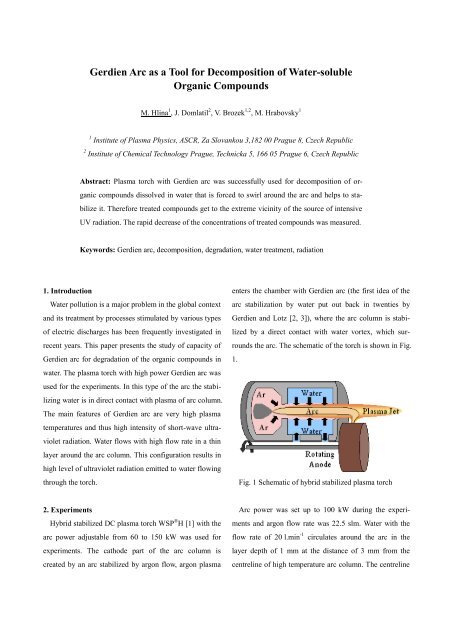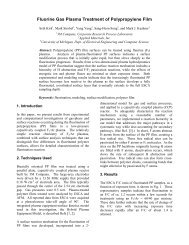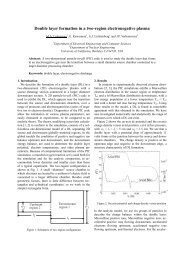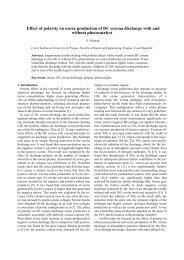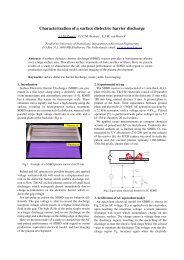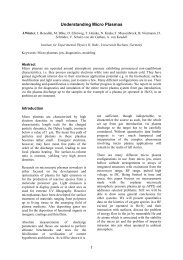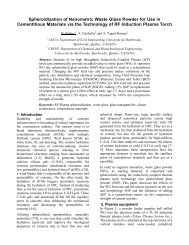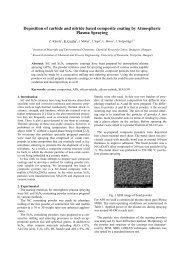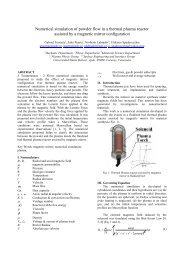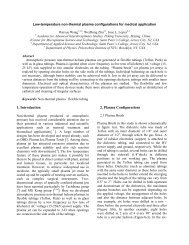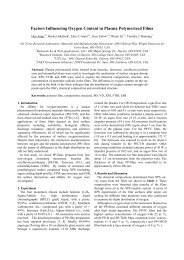Template of 1-page (A4 size) abstracts for ISPC19,
Template of 1-page (A4 size) abstracts for ISPC19,
Template of 1-page (A4 size) abstracts for ISPC19,
- No tags were found...
Create successful ePaper yourself
Turn your PDF publications into a flip-book with our unique Google optimized e-Paper software.
Gerdien Arc as a Tool <strong>for</strong> Decomposition <strong>of</strong> Water-solubleOrganic CompoundsM. Hlina 1 , J. Domlatil 2 , V. Brozek 1,2 , M. Hrabovsky 11 Institute <strong>of</strong> Plasma Physics, ASCR, Za Slovankou 3,182 00 Prague 8, Czech Republic2 Institute <strong>of</strong> Chemical Technology Prague, Technicka 5, 166 05 Prague 6, Czech RepublicAbstract: Plasma torch with Gerdien arc was successfully used <strong>for</strong> decomposition <strong>of</strong> organiccompounds dissolved in water that is <strong>for</strong>ced to swirl around the arc and helps to stabilizeit. There<strong>for</strong>e treated compounds get to the extreme vicinity <strong>of</strong> the source <strong>of</strong> intensiveUV radiation. The rapid decrease <strong>of</strong> the concentrations <strong>of</strong> treated compounds was measured.Keywords: Gerdien arc, decomposition, degradation, water treatment, radiation1. IntroductionWater pollution is a major problem in the global contextand its treatment by processes stimulated by various types<strong>of</strong> electric discharges has been frequently investigated inrecent years. This paper presents the study <strong>of</strong> capacity <strong>of</strong>Gerdien arc <strong>for</strong> degradation <strong>of</strong> the organic compounds inwater. The plasma torch with high power Gerdien arc wasused <strong>for</strong> the experiments. In this type <strong>of</strong> the arc the stabilizingwater is in direct contact with plasma <strong>of</strong> arc column.The main features <strong>of</strong> Gerdien arc are very high plasmatemperatures and thus high intensity <strong>of</strong> short-wave ultravioletradiation. Water flows with high flow rate in a thinlayer around the arc column. This configuration results inhigh level <strong>of</strong> ultraviolet radiation emitted to water flowingthrough the torch.enters the chamber with Gerdien arc (the first idea <strong>of</strong> thearc stabilization by water put out back in twenties byGerdien and Lotz [2, 3]), where the arc column is stabilizedby a direct contact with water vortex, which surroundsthe arc. The schematic <strong>of</strong> the torch is shown in Fig.1.Fig. 1 Schematic <strong>of</strong> hybrid stabilized plasma torch2. ExperimentsHybrid stabilized DC plasma torch WSP ® H [1] with thearc power adjustable from 60 to 150 kW was used <strong>for</strong>experiments. The cathode part <strong>of</strong> the arc column iscreated by an arc stabilized by argon flow, argon plasmaArc power was set up to 100 kW during the experimentsand argon flow rate was 22.5 slm. Water with theflow rate <strong>of</strong> 20 l.min -1 circulates around the arc in thelayer depth <strong>of</strong> 1 mm at the distance <strong>of</strong> 3 mm from thecentreline <strong>of</strong> high temperature arc column. The centreline
plasma temperature that was measured by optical emissionspectroscopy is 19 000 K [1]. Water is injected tangentiallyinto the arc chamber under constant pressure andflow rate and evaporates at the rate <strong>of</strong> 15 g.min -1 . Thisvalue is possible to neglect with regard to the volume <strong>of</strong> awater tank (40 l) and also to the water mass flow rate (20kg.min -1 ). Water-soluble organic compounds such as dyeOrange II, nicotine, oxalic acid and other were placed intothe water tank. Water is <strong>for</strong>ced by a pump to flow throughthe system and swirl around the arc (Fig. 2).Fig. 3 Decrease <strong>of</strong> Orange II concentration during experiment.Fig. 2 Simplified scheme <strong>of</strong> plasma torch water systemPresented results show decomposition <strong>of</strong> dye Orange II(1.4 g ~ 10 -4 mol.l -1 ) and nicotine (0.53 g ~ 8.2.10 -5mol.l -1 ). The changes <strong>of</strong> concentrations were measured bymeans <strong>of</strong> UV/Vis spectroscopy. Intermediates (and partiallyalso final products) produced during degradation [4]were analyzed by total carbon (TC), total organic carbon(TOC), and total inorganic carbon (TIC) measurements.3. Results and discussionAbsorbance is directly proportional to concentration:A lc(1)where A is absorbance, ε molar absorptivity, l path lengthand c concentration. Absorbance maxima in the spectra <strong>of</strong>treated water that were measured at different times <strong>of</strong>experiment showed rapid decrease <strong>of</strong> the concentrations<strong>of</strong> dye Orange II (Fig. 3 and 4).Fig. 4 Comparison <strong>of</strong> the dye concentration in water inflowingthe torch and out-flowing the torch.It is possible to see that decomposition proceeds withhigh effectiveness. All treated dye Orange II passing thetorch is decomposed, however, some organic residualswithstood as analyses <strong>of</strong> total organic carbon revealed.Seemingly slow decomposition rate in Fig. 3 is caused bysampling from the place after the water tank (sampling A)where treated and untreated water is mixed so the resultantconcentration can be described by this equation:dC R(2) Cdt Vwhere R is water flow rate (20 l.min -1 ), C concentration, ttime <strong>of</strong> experiment and V the volume <strong>of</strong> the watertank (40 l).
Successful decomposition can be explained by very intensiveUV radiation that is emitted by the arc plasma dueto its high temperature because centre line temperature is19000 K at 100 kW [1]. The wavelength (λ max ) correspondingto the maximum intensity <strong>of</strong> radiation and otherradiation properties might be calculated [5, 6]. λ max <strong>for</strong> theconditions <strong>of</strong> the experiments (at power <strong>of</strong> 100 kW)equals approximately to 150 nm so the emitted UV fallsinto the far ultraviolet radiation range (FUV) with extremelyhigh energy per photon.It is necessary to mention that also some reactive species(such as H· and OH· radicals, H 2 O 2 etc.) are <strong>for</strong>medthrough the excitation and/or ionization <strong>of</strong> the water moleculesby the energetic electrons [7, 8] and the speciesreact with treated substance. The degradation process willbe probably caused by the joint influence <strong>of</strong> the both effects(UV and reactive species).Analyses <strong>of</strong> total carbon (TC), total organic carbon(TOC), and total inorganic carbon (TIC) showed fast decrease<strong>of</strong> organically bound carbon, however, not as fastas the absorbance spectra revealed (see Table 1.).Table 1. Total carbon (TC), total organic carbon (TOC),and total inorganic carbon (TIC).It is comprehensible when assuming the complex system<strong>of</strong> chain reactions that lead to the utter decomposition<strong>of</strong> molecules with high molecular weight (Fig. 5). Organicfragments (intermediates) are <strong>for</strong>med and analyzed astotal organic carbon (TOC). The slight increase <strong>of</strong> totalinorganic carbon is caused by the <strong>for</strong>mation <strong>of</strong> carbonateswhich are <strong>for</strong>med by the oxidation <strong>of</strong> carbon present atthe organic fragments.Fig. 5 Nicotine (mol. weight ~ 162 g.mol -1 ) andOrange II (mol. weight ~ 350 g.mol -1 )Also other compounds such as oxalic acid and chloralhydrate (trichloroacetaldehyde monohydrate) were decomposedby the flow through the torch.4. ConclusionsIt has been shown that Orange II and nicotine dissolvedin water were decomposed successfully in hybrid stabilizedtorch WSP ® H [1], where the treated water flowsthrough the torch and is in a direct contact with the arc sowith the very intensive source <strong>of</strong> far ultraviolet radiationthat is probably the main cause <strong>of</strong> the degradation. However,other not fully understood mechanisms supposedlyplay a role in degradation process as well. The effectiveness<strong>of</strong> the process was determined by the measurements<strong>of</strong> absorbance spectra and analyses <strong>of</strong> total carbon (TC),total organic carbon (TOC), and total inorganic carbon(TIC).The direct placing <strong>of</strong> a treated substance into the part <strong>of</strong>the plasma torch equipment – into the water circuit thatstabilizes the arc column revealed the principal possibility<strong>of</strong> such an application. However, the torch and the watersystem have not been optimized <strong>for</strong> such experiments and
the presented experiments concern just principal testing<strong>for</strong> several chemical compounds. That leads to the factthat the ratio energy to mass <strong>of</strong> decomposed compound isnot pr<strong>of</strong>itable at all. The optimization <strong>of</strong> the system wouldhave to include the decrease <strong>of</strong> the torch power and/or theincrease the flow rate through the torch. Also mixing <strong>of</strong>treated and untreated water is not convenient and shouldbe avoided in the optimized system. Higher concentration<strong>of</strong> treated compounds would also increase the effectiveness<strong>of</strong> the process.[7] W. J. Bian, M. H. Zhou and L. Ch. Lei, Formations<strong>of</strong> active species and by-products in water by pulsedhigh-voltage discharge, Plasma Chem. Plasma Proc.27 (2007) 337.[8] P. Lukes and B. R. Locke, Plasmachemical oxidationprocesses in a hybrid gas–liquid electrical dischargereactor, J. Phys. D: Appl. Phys. 38 (2005)4074–4081.The authors gratefully acknowledge the support <strong>of</strong> thiswork by the Grant Agency <strong>of</strong> the Czech Republic under theproject No. 202/08/1084.References[1] M. Hrabovsky, V. Kopecky, V. Sember, T. Kavka, O.Chumak and M. Konrad, Properties <strong>of</strong> hybrid water/gasDC arc plasma torch, IEEE Trans. on PlasmaScience 34 (2006) 1566.[2] H. Gerdien and A.Lotz; Wiss. Ver<strong>of</strong>fentlichungenSiemenswerk 2 (1920) 489.[3] H. Gerdien and A. Lotz, On a Light Source <strong>of</strong> VeryHigh Intensity, Z. Tech. Phys. 4 (1923) 157.[4] D. Moussa, A. Doubla, G. Karagang-Youbi and J. L.Brisset, Postdischarge long life reactive intermediatesinvolved in the plasma chemical degradation <strong>of</strong> anazoic dye, IEEE Trans. On Plasma Sci. 35 (2007)444.[5] J. Jenista, M. Bartlova and V. Aubrecht, Czech. J.Phys., Per<strong>for</strong>mance <strong>of</strong> water and hybrid stabilizedelectric arcs: the impact <strong>of</strong> dependence <strong>of</strong> radiationlosses and plasma density on pressure, vol. 56 (Suppl.B) (2006) B1224.[6] V. Aubrecht and M. Bartlova, Radiation absorptioncoefficients in arc plasmas, Czech. J. Phys., vol. 54(2004) 759.


